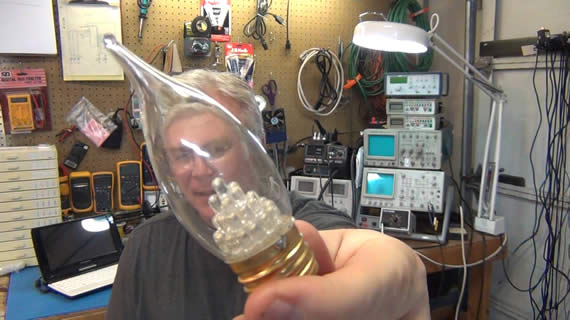My wife bought a candelabra LED style bulb to test in one of our chandeliers. We had hoped to drop from using 40 watt incandescent to 2 watt LED bulbs.

That would be a saving of 228 watts in one chandelier and throughout our house the swap would have a total savings of 570 watts. Not a bad idea but the one we bought to test died in less than 2 weeks. It might have only been one week even.
I thought it would be fun to dissect it and see how it failed and maybe how it worked. Here is the video:
What better way to dissect electronics than with a hammer. “I got me’amer” – Photonic Induction.

It hammered apart quite nicely without any damage to the innards.
CLICK TO READ ALL —>:

The pyramid was just a pack for 28 LED’s tightly packed using insulated standoff tubes. I was not sure at first if all the LED’s were in series or if there was some paralleling going on so the voltage could be lower to drive the LED’s.

It was not a complicated circuit. Some filter caps, two resistors, a diode and a SMD bridge rectifier.

Holly crawdads! It still works? I’m thinking the shrink wrap around the PCB was a bit small and it had managed to short the case to the wire feeding the LED’s. I also noticed one leg of the MB6S bridge rectifier IC was not soldered down and it had almost zero copper under the leg so that could have been causing an intermittent as well.

The Fluke says the PCB is putting out ~81V DC.

The AC ripper riding at the 81V DC offset was quite pronounced at 26V PP. But the LED’s didn’t seem to mind and the human eye couldn’t pickup any 120 Hz flashing if it was causing a problem.

The LED’s themselves draw 9.45mA. Not bad for 40 watts of equivalent incandescent lighting output.

I set my power supply to series mode to output my max at 63v DC. That wasn’t enough DC directly across the 28 LED’s to turn them all on so without any further circuit tracing I can tell the LED’s are in series being each white LED needs over 2v to be forward biased.

I must have been real close to turning the pack on with 63v DC because when I jumper across a couple less LED’s the rest of the LED’s came on. A little more probing with the 63v DC source went too far and “I popped’it” – Photonic Induction again :) I sure wish Photonic Induction wouldn’t have pulled off of YouTube. I loved that YouTube channel. The blackened LED’s are the ones I popped with too much voltage. :( It was fun while it lasted.

Thank you for joining.
Todd

